Plans for an Information Philosophy Institute
Design and Building (September 17, 2018)
Please see a summary of events in early 2018 that led to these plans.
We collect all our thoughts in a single document so a general contractor can understand the full scope of possible work.
But we divide the work into sub-projects so a single contractor could take full responsibility for a project element (e.g., the new door and stair, foundation waterproofing, solar panels, or tunnel to garage).
We are now planning to work with a general contractor who will take on most of the work, and we are working with an HVAC specialist who installed mini-split air conditioning for the lab and studio on the first floor, and will install a new highly-efficient forced hot water heating system for the building.
At this point, important project elements are
Demolition of Boilers-Pipes-Radiators, Ceilings, Walls, Obsolete Wiring,
We decided to do the demolition ourselves to get a good look at any problems and we found significant damage hiding behind the walls and ceilings.
The basement had a horsehair plaster and lathe ceiling attached to floor joists, then a drop ceiling suspended a few inches below. The plaster had been pierced to install fluorescent lighting up between the joists. Plaster was crumbling and falling down in many places, making the basement dusty and dirty.
To get a clear look at floor joists and first-floor planking, we decided to remove the drop ceiling and demolish the plaster and drop ceilings. The drop ceiling averaged about 4" below the joists, reducing ceiling height below seven feet.
Steam pipes were too low for the headroom required by Massachusetts and Cambridge building codes. We decided to switch from steam heat to forced hot water. We removed and recycled two inefficient steam boilers, seventeen very heavy upstair radiators, and many feet of heavy black pipe. These will be replaced with panel radiators and light-weight PEX piping.
Electrical wires, thirty Merlin PBX wires, doorbell wiring, security camera wiring, and many other wires criss-crossed the cellar, lying on the ceiling tiles and randomly breaking through the plaster, which was constantly disintegrating into dust.
The oldest electrical wires were deteriorating cloth-insulated inside ancient BX metal armor.
Low-voltage electronics cables from our webcasting studio to the switcher and green room were very difficult to manage.
We removed all of the BX and several obsolete wires, many of which were wrapped over and under pipes and haphazardly stapled to beams and joists with non-insulated staples. All horizontal BX was replaced with Romex. We reorganized locations for wires, attaching them neatly with insulated staples. Wires now run only down the long corridor between the main beams, then out between the joists.
This also provides us clear open paths for PEX piping between the main load beams and up between the floor joists for the new forced hot water heating system.
With all joists exposed, we did a survey of ceiling heights. In the front corners the height to the joists is 7'4" and averaged 7'3" across the space toward the outer walls. The main beams in the center are typically 7'1". We initially thought we might have to dig out the concrete floors, but that very expensive possibility is now not necessary.
We plan to install 1/2" ceilings, removable plywood panels, and perhaps thin vinyl sheet flooring or ceramic planking, so will have the Massachusetts state building code basement ceiling height everywhere. See code below.
There was no blocking between the joists, so at many places floorboards were spongy and noisy, pulled loose from the sub-floor.
We removed the sheetrock outer walls, studs, etc. Some studs and many 2" x 4" bottom plates were badly rotted.
We demolished the existing interior walls that must be moved to new places for the new boiler room, a larger bathroom, and for the new workshop wall.
We removed the old vinyl floor tiles in preparation for new flooring. The concrete floor is uneven by as much as an inch, so we probably must flatten it (though not level it) for new flooring.
We demolished the walls and ceiling of the first floor bathroom, partly to run new drain pipes that do not compromise our new sistered joists, and because we want to install a walk-in shower.
Sistering Joists, Replacing Parts of Main Beams, and new Lally Columns
We found water and termite damage to the back ends of main beams and several joists below the upper-floor bathrooms. Plumbers had cut deeply into the joists to position the bathtub drains and upper floors were sagging well below their original level.
We consulted a structural engineer whose report said that weak joists should be sistered with new 2" x 8" LVL planks. For the termite-damaged main beams, he recommended removing them and installing three new 2" x 10" LVL boards to replace the bad beams.
We got an extravagant estimate ($69,000) for sistering ten joists, replacing 20 feet of each main beam, and adding two new columns with new reinforced concrete footings. We got a lower estimate for just sistering the joists ($10,000), but still very expensive.
So we went ahead and sistered the seven worst joists ourselves with new 2" x 8" LVL planks. We also strengthened the "cripple box" around the plumbing stack.
We used six 20-ton hydraulic jacks to shore up the joists, taking weight off the beams, so we could remove the damaged sections in small pieces.
We replaced the damaged 20 feet of each 6" x 10" beam with three 2" x 10" LVL lumber, each pair screwed together with Headlok 2 3/4" screws and glued with Liquid Nails Extreme. The three planks are bolted together with 1/2" bolts every 1.5 feet.
Under the main beams we replaced three lally columns that were deteriorating. We relocated two columns to be hidden in wall partitions, setting them on new concrete footings with reinforcing rebars.
Once all floor joists are strong, we may need a new subfloor and hardwood or laminate flooring in the first floor corridor, with blocking/bridging between floor joists as needed to prevent squeaking (or perhaps just new brad nails secured to old subfloor?).
A new forced hot water heating system will be installed in about half the space of the old boiler room.
Gas entrance pipes need to be relocated up between the now-open joists, and boxed along the exterior wall.
Fire retardant walls and ceiling for the boiler room? Maybe not, because new boilers have sealed combustion chambers with no open flames.
System should have zone control for the three upper floors and for future basement and garage heating.
About 17 new European style, white wall-mounted radiators will be installed on the upper three floors.
Wirsbo/Uponor AquaPEX (PEX-A) piping will mostly follow the existing holes for the old steam radiators. Pipes will travel from the new boiler room along the corridor between the main beams, then our between floor joists to the rooms.
We hope to hide most piping above the ceiling between joists and down inside partitions.
Replace the hot water heater with an indirect tank with heat exchanger in the boiler.
Manifolds needed
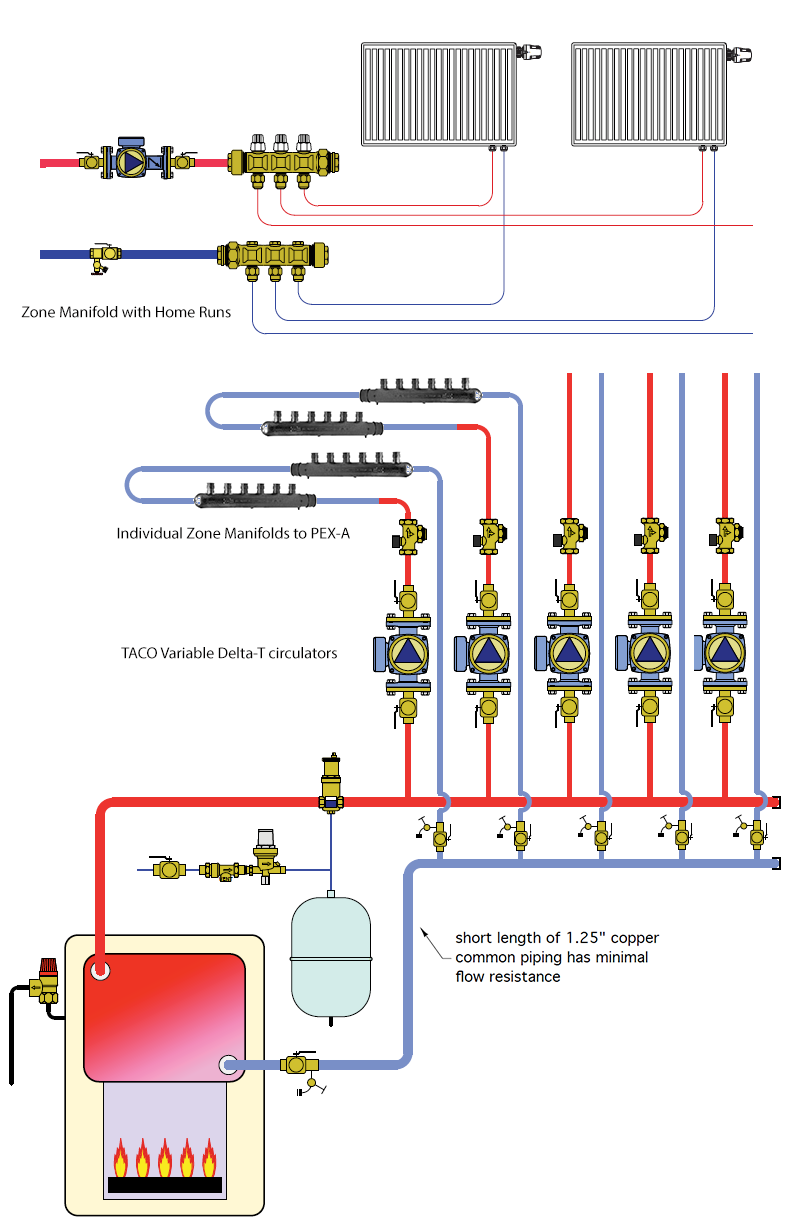
-
A 5-zone master manifold in boiler room with variable delta-T circulators. (Size? 1.5 in. input, 3/4 out?)
-
Three 5-loop manifolds (e.g., 3/4 in, 1/2 out?), one for each floor/zone, mounted above corridor between main beams with flow restrictions and home runs to radiators. Front/middle bedrooms and rear bedroom/bath each share one home run. Large front rooms have two home runs. Kitchen has one.
-
Thermostatic valves on all radiators to balance room temperatures?
More details on our heating plans.
Mini-split air conditioning for the first floor lab, webcasting studio, and guest room.
Since we removed all the ceilings in the cellar, we can also send refrigerant lines from the outside compressor/condenser to the wall-mounted units inside by traveling between the main cellar beams and between the joists to the outside walls.
Fujitsu components
-
AOU45RLXFZ multi-zone outdoor unit, installed on the concrete sidewalk outside the northeast wall
- Two ASU12RLF1 wall mounts in the main studio, whose temperature rises 20 degrees when the studio is operating. One at the front door, the other at the back of the room, near the heavy equipment in the hutch.
- One ASU12RLF1 in the green room.
- One ASU12RLF1 in the front and middle offices, which are openly connected.
- One ASU7RLF1 in the rear office/guest room
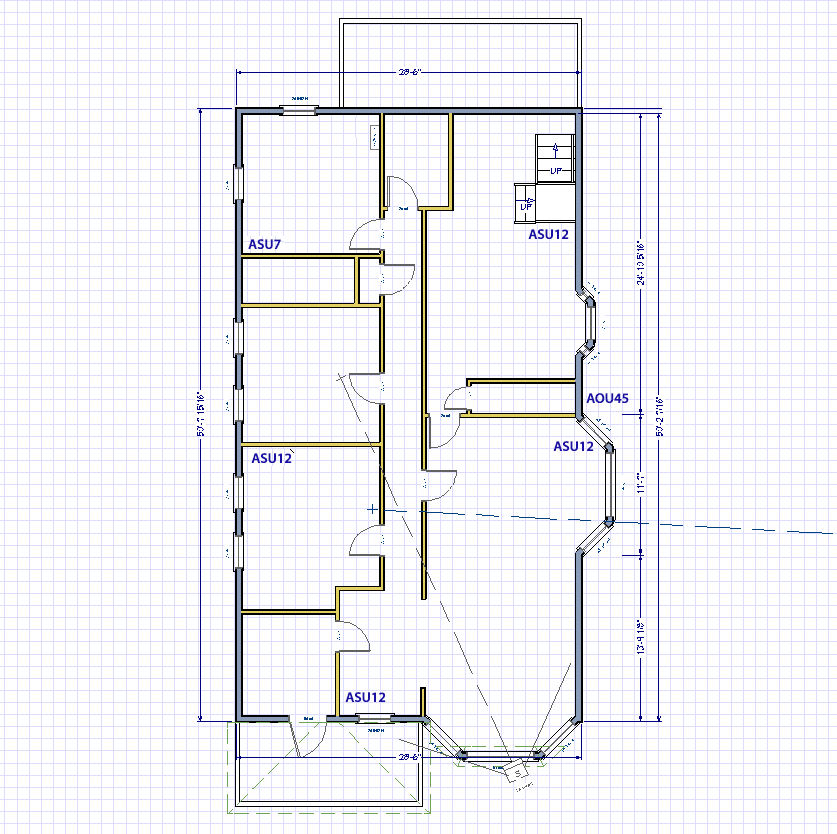
We installed a new 30A circuit and circuit breaker for the outdoor unit.
Foundation Waterproofing and Possibly Sump Pumps to Prevent Flooding
With all the exterior walls now visible, we ran water through a garden hose around the house perimeter and saw water coming through the rubble foundation in some places. We may need to dig outside and waterproof the foundation walls from the outside. As additional protection, we may add one or perhaps two sump pumps at the front to eliminate future floods? Although we will test the outside waterproofing first.
We will also add new downspouts on porches at front and rear to keep water away from the house foundation.
We will repoint the lower half of exterior walls (rubble foundation) with new hydraulic lime mortar.
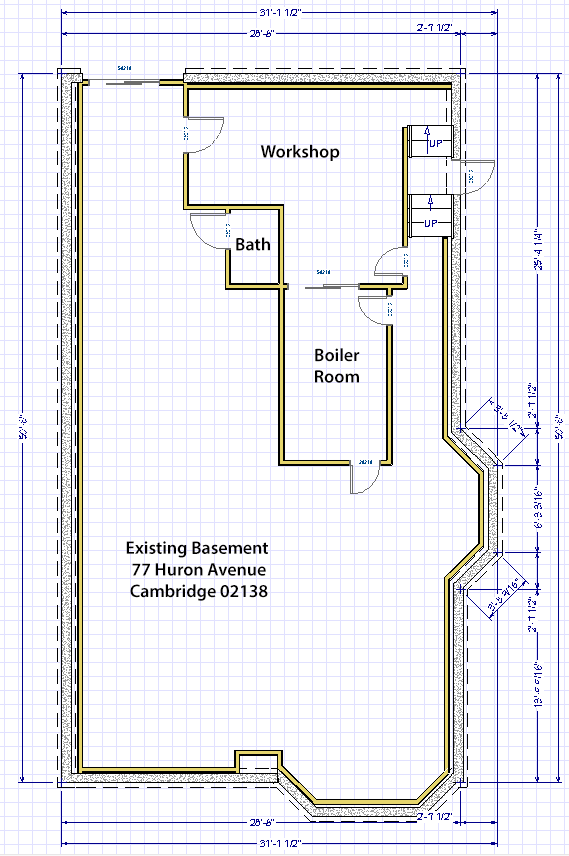
Major Basement Changes
- New door and stair at front of the basement, opening on the driveway, to provide another safe egress. Upper stairs are supported entirely by the adjacent walls
- Replace 6-foot sliding door at rear with a standard 80" door at the head of the stair (will need to remove concrete steps, replace with wood). We hope to house the new stairs inside the basement, surrounded by new exterior walls and roof, replacing existing open roof.
-
New double-pane casement hopper windows, with screens.
-
Renovate the existing half-bath to include a walk-in shower.
-
Move two Lally columns into the bathroom walls.
-
Move existing workshop wall back to line up with bathroom, move the workshop sink.
-
Add a new kitchen sink and counter for kitchenette along the workshop wall. Space for microwave, convection oven, and small refrigerator.
-
Remove one Lally column that obstructs the kitchen counter. Add two new 3.5" steel tube columns, .220" wall with new footings and 6" x 6" top plate supporting the three 2" x 10" x 12' LVL planks.
-
Basement floor covering was vinyl tile. Instead of vinyl we need to flatten the concrete floor and install ceramic/porcelain planks that are waterproof, for example Daltile PF01 Ice.
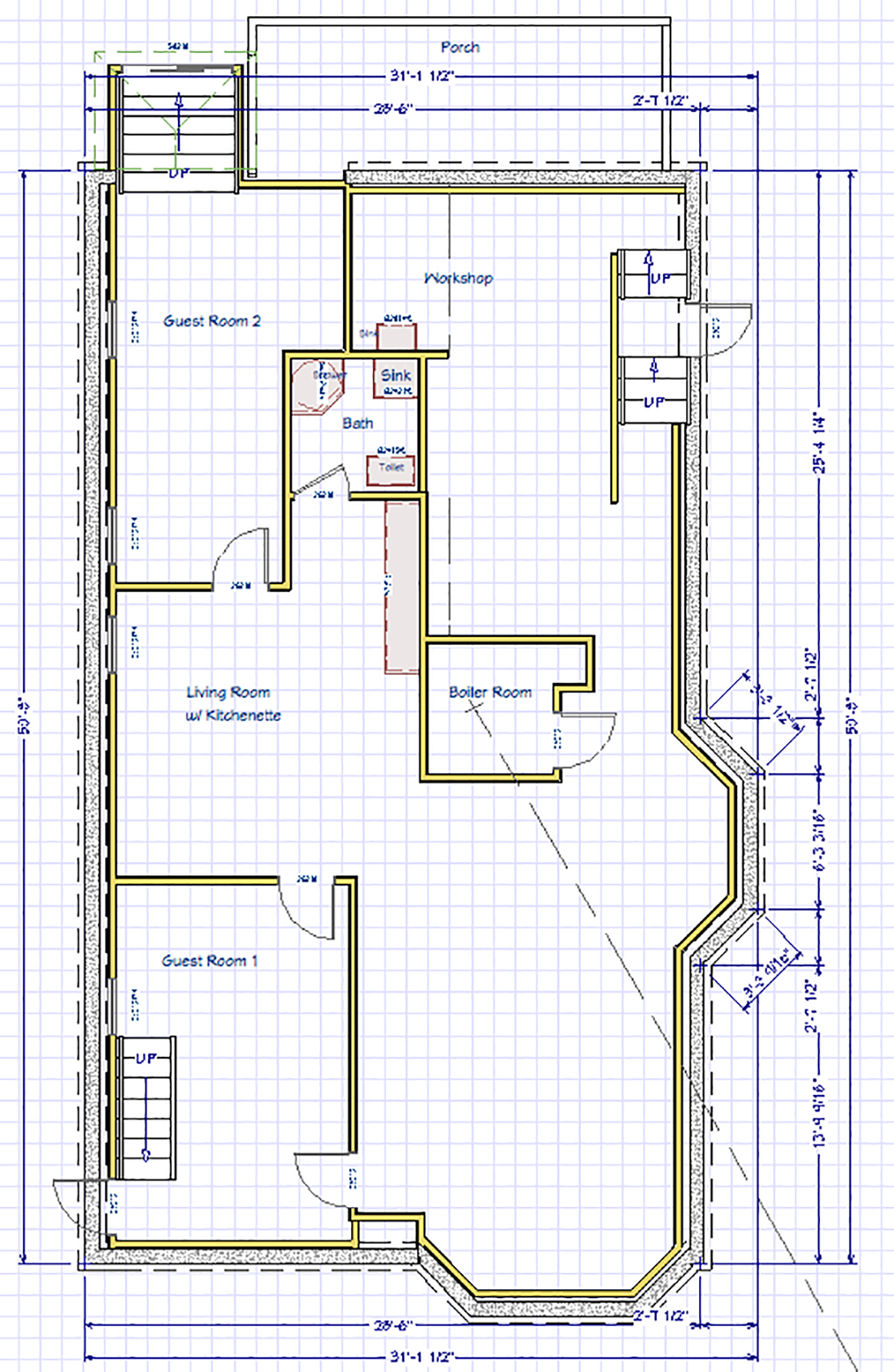 Download PNG
Download PNG
Renovate First Floor Bathroom for the iTV-Studio and Guest Room
We demolished the walls and ceiling of the first floor bathroom and will build a new stud wall at 60" separation to accept a new walk-in shower.
We added sister joists below the bathroom floor to strengthen those badly cut away for cast iron drain pipe access below first floor bath. We will thread new PVC piping through holes, not notches, in the new sistered joists, or perhaps in the first floor bathroom wall?
Proposed fixtures for first floor bathroom.
We hope to cut the 0.2" wall material to allow us to keep the window. 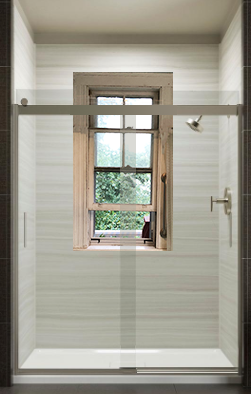
New Outer Walls, Ceilings, and Partitions for Two Guest Rooms in Basement
-
R-19 insulation between floor joists for sound isolation and fireproofing. For example, Owens Corning EcoTouch PINK.
It must be mounted to the floor above so we can run future low-voltage studio wiring, doorbell wiring, new electric outlets, mini-split air conditioning lines, and others not yet known.
-
Removable ceiling panels, many with recessed LED lighting fixtures with integrated junction boxes. Three-way switches for recessed downlights. Single switches for "fluorescent-style" LED tube worklights and illumination of the "museum" shelves.
-
Upper four feet of exterior walls will have built-in bookshelves with alternating verticals "bookworm" style. We must design and build a four-foot section of the exterior wall as a model.
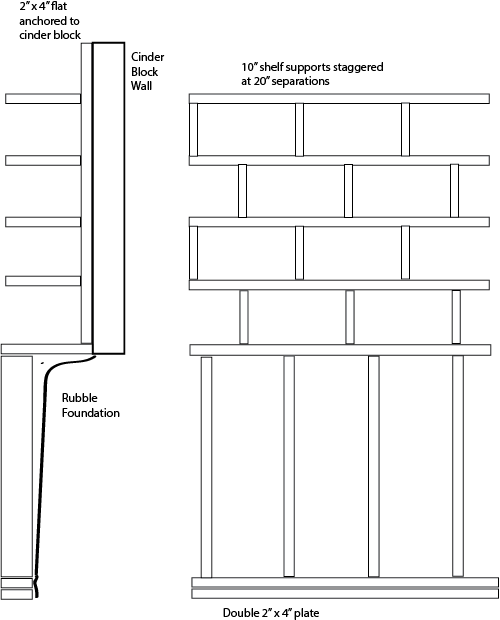
The lower plate will be 5/4" x 4" PVC. Upper plate will be pressure-treated 2" x 4".
-
Thin rigid insulation (R-7.5 FOAMULAR 150 1-1/2 in.) or spray foam on the upper cement-block wall behind bookshelves.
-
R-13 insulation (Poly Faced Fiberglass OR Foamular 1.5" on top of 2.0" sheets) behind lower half of exterior walls against the rubble foundation
-
R-13 insulation also in all interior partition walls to block sound. R-19 in workshop walls.
-
Electric outlets in partitions on all four walls of each room. In the kitchenette we need multiple 20A outlets with GFCI.
-
Small air conditioners in guest rooms mounted in the cement blocks under front and rear porches? Or possibly portable air conditioners with a 5-inch duct that we will mount on a shelf. We will cut the 5-inch hole in the cement blocks with our core bit.
-
Radiator pipes (PEX-A) in partitions and possible looped through joists as radiant heating.
-
Proposed bedrooms have been moved to include the two entrance stairs/doors for emergency egress. The LR/kitchenette and bath are now in the middle.
-
New vinyl sheet flooring glued down with Henry 650R Releasable Bond Pressure Sensitive Adhesive in basement, perhaps different designs in different rooms?
-
Or perhaps ceramic/porcelain planks that are completely water resistant. For them, we will need to level or at least flatten many parts of the cellar floor. Once the partitions are up, we will do it room by room or one section at a time. We need some underlayment such as a mortar bed, like that used under our shower bases.
Front Stair Design
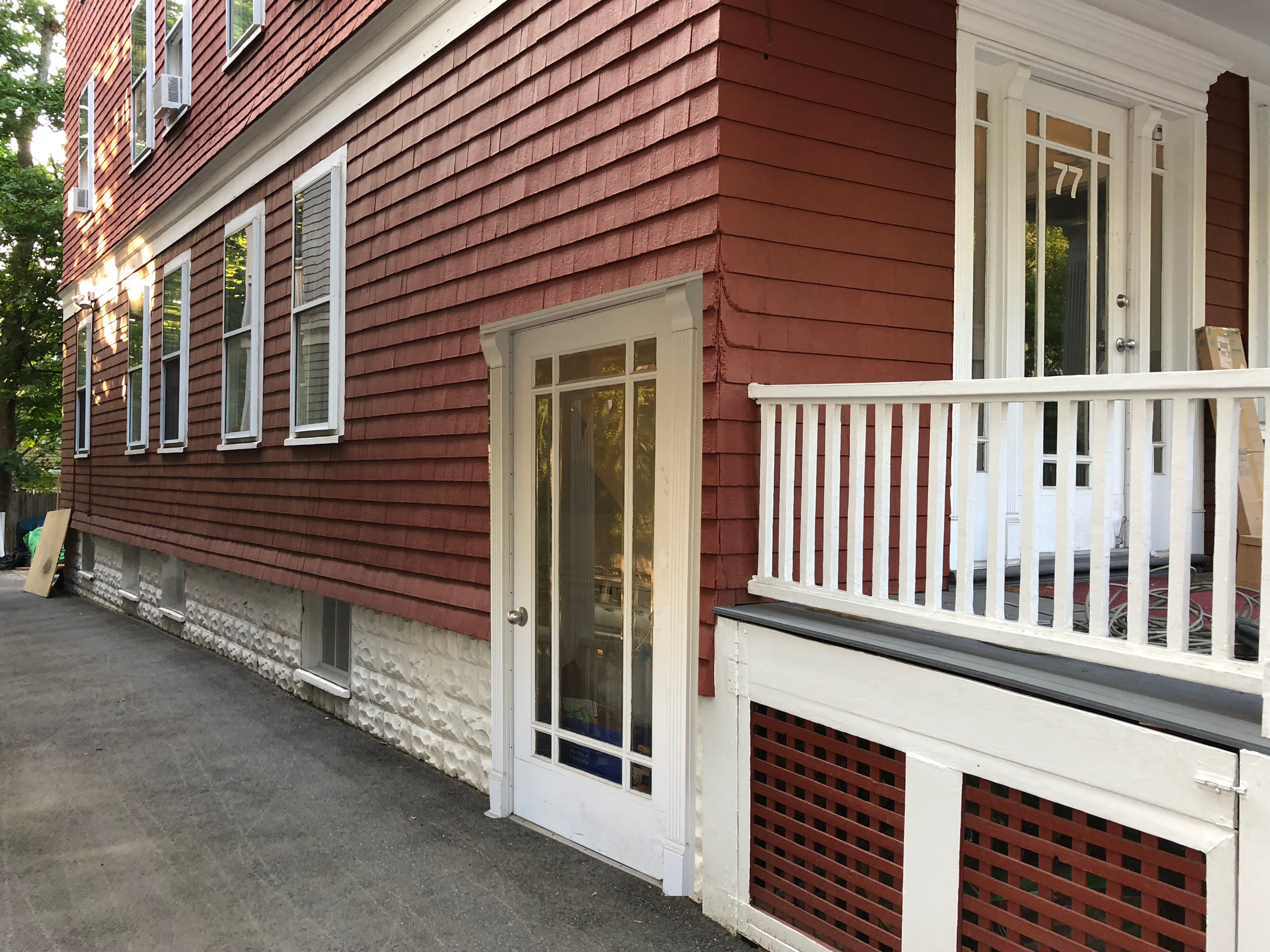 Visualization of new side entrance, a 36" x 78" (or probably 32" x 78") much like our current front door.
Should the door open out or in?
Because its 3-foot by 3-foot landing is a few feet below the vestibule of the first floor, it has only eight stairs instead of 13 in the upper floor staircase.
Because the rubble foundation extends 7" inside the cement block wall, the stairs are only 30" wide where upper floors are 36".
Since the basement ceiling height is 7'3" at the new stair, compared to upper floors with nine feet, the headroom at the bottom step may be slightly below code.
We inspected the space under the first flight of stairs above. It is completely open. The upper stairs are attached only to the walls.
We need a (30"-wide?) door at the bottom of the stair to block winter cold from rushing in to the basement. Even better might be a second door at the top of the stair to make a mini-vestibule. The outer door could be left-opening out. The inner door at the top of the stair left-opening in. It need only be closed in very cold weather. Perhaps no inner door, but a lightweight folding door that could be out of the way except for the coldest weeks?
With cold blocked at the top of the stair, we could have a banister and newell post, bringing the staircase space into the room.
Visualization of new side entrance, a 36" x 78" (or probably 32" x 78") much like our current front door.
Should the door open out or in?
Because its 3-foot by 3-foot landing is a few feet below the vestibule of the first floor, it has only eight stairs instead of 13 in the upper floor staircase.
Because the rubble foundation extends 7" inside the cement block wall, the stairs are only 30" wide where upper floors are 36".
Since the basement ceiling height is 7'3" at the new stair, compared to upper floors with nine feet, the headroom at the bottom step may be slightly below code.
We inspected the space under the first flight of stairs above. It is completely open. The upper stairs are attached only to the walls.
We need a (30"-wide?) door at the bottom of the stair to block winter cold from rushing in to the basement. Even better might be a second door at the top of the stair to make a mini-vestibule. The outer door could be left-opening out. The inner door at the top of the stair left-opening in. It need only be closed in very cold weather. Perhaps no inner door, but a lightweight folding door that could be out of the way except for the coldest weeks?
With cold blocked at the top of the stair, we could have a banister and newell post, bringing the staircase space into the room.
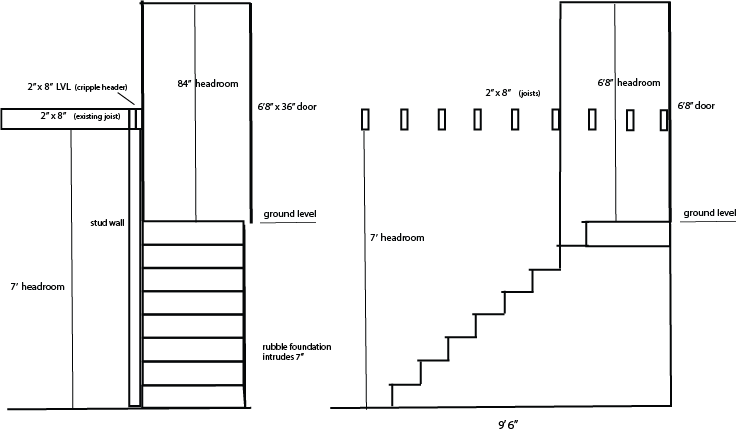
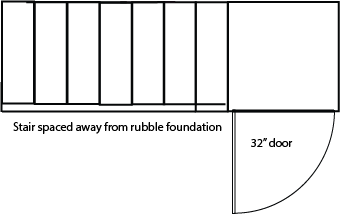
Renovate Basement Bathroom
Enlarge bath from 7' x 3.5' to 7' x 6'.
Existing plumbing works well for toilet and sink.
Probably need to excavate part of bathroom floor to provide a P-trap for a new shower drain. Also will need a sump pump to force shower water up into adjacent sink drain? An "ejector" pump is not needed because shower drain has no solid waste.
Better still is to excavate the entire bathroom floor and install new piping for all fixtures?
Proposed fixtures.
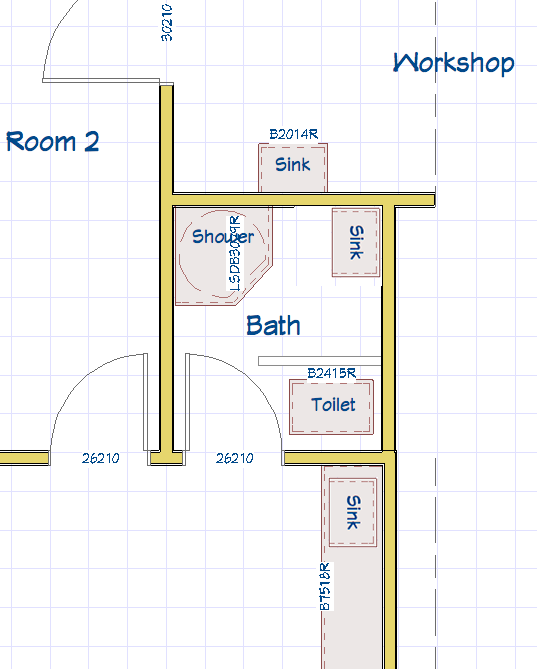
Passageway to/from the Garage
We need a second safe egress from the main garage where we work on our family cars.
When we lose power, it is not possible to lift the heavy overhead door, and in event of fire we would like a second exit.
We propose to replace a 36" x 36" window in the garage with a full-height door. The garage window is 6.5 feet away from and directly opposite a 36" x 24" basement window. We would replace the basement window with a 32"-wide, six-foot-tall door. Both doors need to be steel frames because they are below grade.
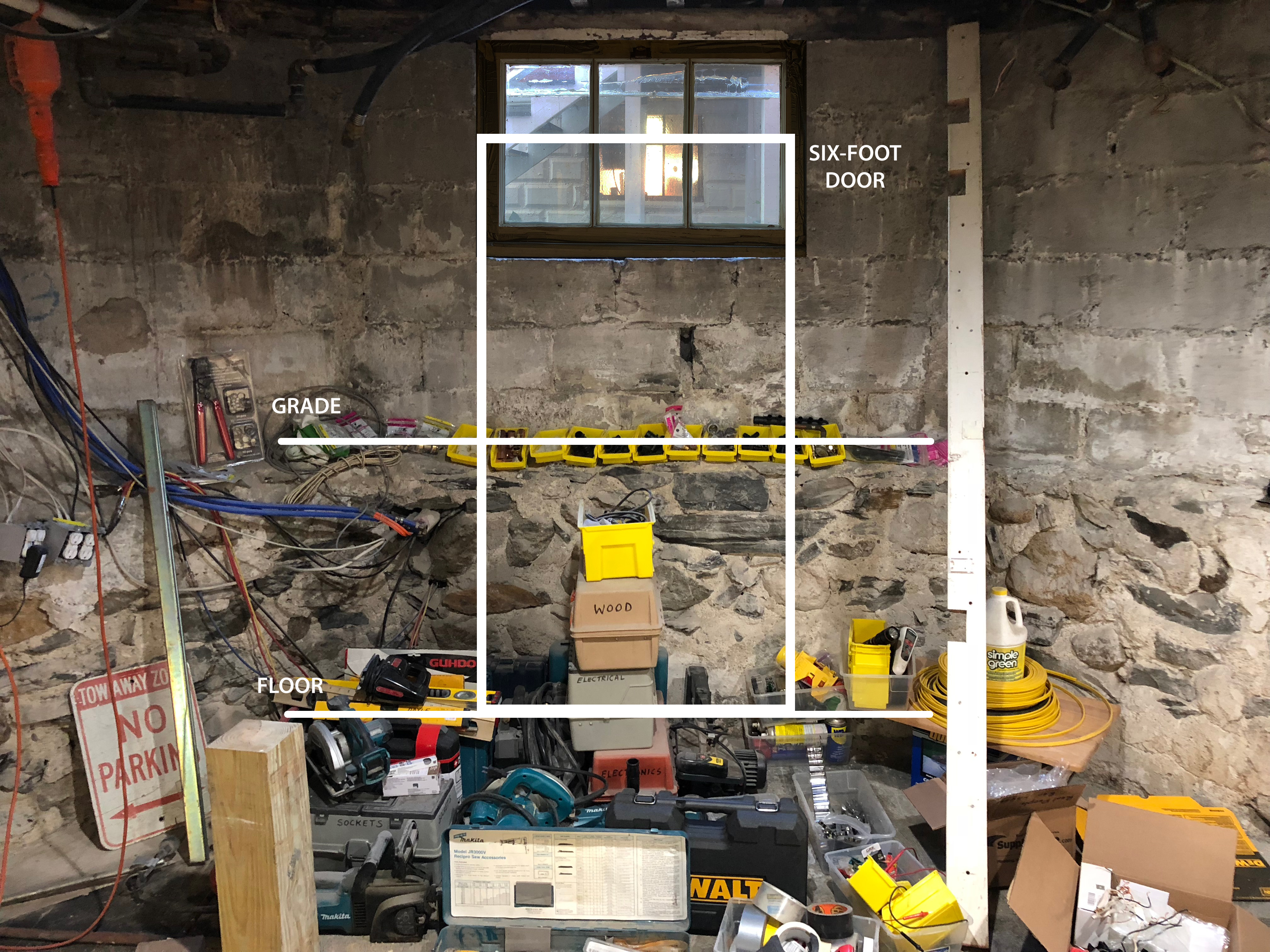 Looking through the basement window, you can see the garage window and part of the stair to the garage roof.
We would replace the current stair with a deck going up six steps, from which four more steps would reach the garage roof. We propose the roof be considered as open space.
Looking through the basement window, you can see the garage window and part of the stair to the garage roof.
We would replace the current stair with a deck going up six steps, from which four more steps would reach the garage roof. We propose the roof be considered as open space.
Solar panels on roof of 77 Huron and possibly 75 Huron
We may need to strengthen the structure of the 77 Huron roof to support an array of solar panels.
The current rubber roof is past its expected life. We have maintained it by resealing the seams and adding a one-foot strip of new rubber on top of the original seams.
Open space on roof of 73 Huron
We have been encouraged to declare the roof of the six garages at 73 Huron to be considered "open space" by the city, perhaps even a "green roof?"
Building Permit Application
A homeowner building permit was filed online 8/24/2018, with the following stipulations;
Fire Protection: You must comply with NFPA 241 - Standard for Safeguarding Construction, Alteration, and Demolition Operations.
Guarantee Fund: Notice is hereby given that owners obtaining their own permit or dealing with unregistered contractors for applicable home improvement work do not have access to the arbitration program or guarantee fund under MGL c.142A.
Noise Ordinance: The undersigned as the Architect / Construction Supervisor / Owner for this proposed construction do hereby certify awareness and knowledge of Chapter 8.16 of the Cambridge Municipal Code regarding noise control. Necessary actions must be taken concerning the design, specification of an location of noise producing equipment; e.g., air condensers, heating equipment exhausts, etc., to insure that this project will not result in noise levels that exceed that allowed by the Municipal Code.
Demolition: For substantial demolition of any structural elements of more than 25% of existing building, detailed information of demolition must be included on construction drawings (proof of extermination required if excavating or demolition). Demolition of more than 25% of the existing area or volume of the structure requires a Demolition Permit.
Construction Debris: As a result of the provisions of MGL c 40 §54, I acknowledged that as a condition of the Building Permit, all debris resulting from the construction activity governed by this Building Permit shall be disposed of in a properly licensed waste disposal facility, as defined by MGL c 111 §150A.
Structural Peer Review: Required for high rise construction or buildings of unusual complexity as determined by the BBRS
Lead Safe Renovation Contractor License: This license is required and issued by the Massachusetts Department of Labor Standards (454 CMR 22.03(3)). This license is required for ALL renovation work on residential buildings constructed before 1978. The DLS licensed lead supervisor is required to be on-site at all times during the lead-disturbance phase of the project
Asbestos and Other Hazardous Materials: The undersigned as the Architect / Construction Supervisor / Owner for this proposed project do hereby certify that awareness and knowledge of contaminants in the building or on the site will require necessary action for remediation of hazardous materials by a contractor licensed for hazardous waste remediation. All debris resulting from remediation will be disposed of in a properly licensed hazardous waste disposal facility.
The undersigned hereby certifies that he/she has read and examined this application and that the proposed work subject to the provisions of the Massachusetts State Building Code and other applicable laws and ordinances is accurately represented in the statements made in this application and that the work shall be carried out in accordance with the foregoing statements and in compliance with the provisions of law and ordinance in force on the date of this application to the best of his/her ability.
The undersigned, by printing his/her name below, hereby certifies under the pains and penalties of perjury that the information herein, and all forms and supporting documentation submitted in support of the application(s), are true and accurate.
Cambridge Zoning Standards and 77 Huron Avenue
Our property is non-conforming with multiple zoning standards from this
ZONING ORDINANCE - CITY OF CAMBRIDGE
ARTICLE 5.000 DEVELOPMENT STANDARDS,
5.31 Residential Districts
|
District
|
1. Max. Ratio of Floor Area to Lot Area (FAR)
|
2. Min. Lot Size
|
Min. Lot Area for each D.U. in Sq. Ft.
|
Min. Lot Width in Feet
|
Minimum Yard in Feet
|
Front
|
Side
|
Rear
|
|
Max. Height in Feet
|
Min. Ratio of Private Op. Sp. to Lot Area
|
|
Res. B
|
0.5
|
5,000
|
2,500
|
50
|
|
35
|
40%
|
|
77 Huron
|
1.16
|
3745
|
3745/3 = 1248
|
40
|
|
35
|
53%
|
Excerpt from Cambridge Property Database for 77 Huron Avenue
Property Value
| Year of Assessment | 2018 |
|---|
| Tax District | R6 |
|---|
| Residential Exemption | Yes |
|---|
| Building Value | $799,800 |
|---|
| Land Value | $845,300 |
|---|
| Assessed Value | $1,645,100 |
|---|
| Sale Price | $42,500 |
|---|
| Book/Page | 12493/ 731 |
|---|
| Sale Date | August 3, 1973 |
|---|
| Previous Assessed Value | $1,604,400 |
|---|
Owner Information
| Owner(s) | DOYLE, ROBERT D. &
HOLLY THOMIS DOYLE
77 HURON AVE
CAMBRIDGE, MA 02138-6798 |
|---|
Building Information
Residential Building Number 1, Section 1
Exterior
| Style | DECKER |
|---|
| Occupancy |
THREE-FM-RES |
| Number of Stories | 3 |
|---|
| Exterior Wall Type |
Wood Shingle |
| Roof Type |
Flat |
| Roof Material |
Rubber Membrane |
Interior
| Living Area (sq. ft.) | 4,362 |
|---|
| Number of Units |
3 |
| Total Rooms |
18 |
| Bedrooms |
9 |
| Kitchens |
3 |
| Full Baths |
3 |
| Half Baths |
1 |
| Fireplaces |
0 |
Systems
| Heat Type | Steam |
|---|
| Heat Fuel |
Gas |
| Central A/C |
No |
Condition & Grade
| Year Built | 1916 |
|---|
| Interior Condition |
Average |
| Overall Condition | Average |
|---|
| Overall Grade | Good |
|---|
Parking
| Open Parking | 2 |
|---|
| Covered Parking | 0 |
|---|
Subareas
| Code |
Description |
Gross Area |
Living Area |
| FOP |
Porch, Open |
651 |
0 |
| FUS |
Upper Story, Finished |
2,908 |
2,908 |
| BAS |
First Floor |
1,454 |
1,454 |
| FBM |
Basement, Finished |
700 |
0 |
| UBM |
Basement |
754 |
0 |
| Total: |
6,467 |
4,362 |
Ceiling Height - Code of Massachusetts Regulations
CMR: STATE BOARD OF BUILDING REGULATIONS AND STANDARDS
780 CMR 5305 CEILING HEIGHT 5305.1 Minimum Height. Habitable rooms, hallways, corridors, bathrooms, toilet rooms, laundry rooms and basements shall have a ceiling height of not less than seven feet (2134 mm). The required height shall be measured from the finish floor to the lowest projection from the ceiling.
Exceptions:
1. Beams and girders spaced not less than four feet (1219 mm) on center may project not more than six inches (152 mm) below the required ceiling height.
2. Ceilings in basements without habitable spaces may project to within six feet, eight inches (2032 mm) of the finished floor; and beams, girders, ducts or other obstructions may project to within six feet, four inches (1931 mm) of the finished floor.
3. Not more than 50% of the required floor area of a room or space is permitted to have a sloped ceiling less than seven feet (2134 mm) in height with no portion of the required floor area less than five feet (1524 mm) in height.
4. Bathrooms shall have a minimum ceiling height of six feet eight inches (2036 mm) over the fixture and at the front clearance area for fixtures. A shower or tub equipped with a showerhead shall have a minimum ceiling height of six feet eight inches (2036 mm) above a minimum area 30 inches (762 mm) by 30 inches (762 mm) at the showerhead.
5. Ceiling heights in habitable basements, including drop ceilings, shall be a minimum of six feet eight inches (2032 mm).
References
This Old House
Stair Construction
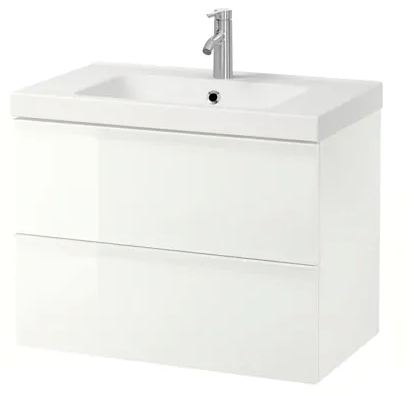
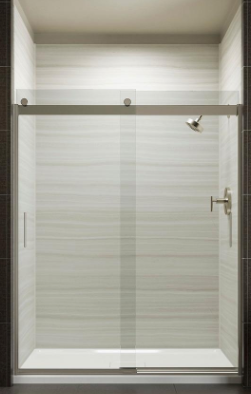



 Download PNG
Download PNG


 Visualization of new side entrance, a 36" x 78" (or probably 32" x 78") much like our current front door.
Should the door open out or in?
Because its 3-foot by 3-foot landing is a few feet below the vestibule of the first floor, it has only eight stairs instead of 13 in the upper floor staircase.
Because the rubble foundation extends 7" inside the cement block wall, the stairs are only 30" wide where upper floors are 36".
Since the basement ceiling height is 7'3" at the new stair, compared to upper floors with nine feet, the headroom at the bottom step may be slightly below code.
We inspected the space under the first flight of stairs above. It is completely open. The upper stairs are attached only to the walls.
We need a (30"-wide?) door at the bottom of the stair to block winter cold from rushing in to the basement. Even better might be a second door at the top of the stair to make a mini-vestibule. The outer door could be left-opening out. The inner door at the top of the stair left-opening in. It need only be closed in very cold weather. Perhaps no inner door, but a lightweight folding door that could be out of the way except for the coldest weeks?
With cold blocked at the top of the stair, we could have a banister and newell post, bringing the staircase space into the room.
Visualization of new side entrance, a 36" x 78" (or probably 32" x 78") much like our current front door.
Should the door open out or in?
Because its 3-foot by 3-foot landing is a few feet below the vestibule of the first floor, it has only eight stairs instead of 13 in the upper floor staircase.
Because the rubble foundation extends 7" inside the cement block wall, the stairs are only 30" wide where upper floors are 36".
Since the basement ceiling height is 7'3" at the new stair, compared to upper floors with nine feet, the headroom at the bottom step may be slightly below code.
We inspected the space under the first flight of stairs above. It is completely open. The upper stairs are attached only to the walls.
We need a (30"-wide?) door at the bottom of the stair to block winter cold from rushing in to the basement. Even better might be a second door at the top of the stair to make a mini-vestibule. The outer door could be left-opening out. The inner door at the top of the stair left-opening in. It need only be closed in very cold weather. Perhaps no inner door, but a lightweight folding door that could be out of the way except for the coldest weeks?
With cold blocked at the top of the stair, we could have a banister and newell post, bringing the staircase space into the room.


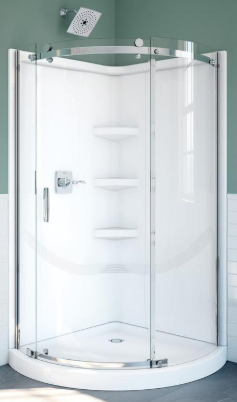

 Looking through the basement window, you can see the garage window and part of the stair to the garage roof.
We would replace the current stair with a deck going up six steps, from which four more steps would reach the garage roof. We propose the roof be considered as open space.
Looking through the basement window, you can see the garage window and part of the stair to the garage roof.
We would replace the current stair with a deck going up six steps, from which four more steps would reach the garage roof. We propose the roof be considered as open space.